The Purest Hunt: Tracking Elephants in Zimbabwe
Tim Herald 09.11.17

I recently returned from an African safari in the Zambezi Valley of Zimbabwe, where I led a group of friends and Worldwide Trophy Adventures (WTA) clients for a mixed bag of buffalo and elephant. I know elephant hunting can be controversial, so I’d like to get a few things straight.
First, elephants are not endangered. CITES issues permits in many countries, and if they were endangered, this wouldn’t be the case. Furthermore, where elephants occur, they are usually overpopulated. Zimbabwe has parks that are absolutely overrun with elephants. One park has more than 10,000 elephants, and the carrying capacity is about 1,500. Botswana’s Chobe National Park is drastically more overpopulated. What happens in these situations is the elephants leave the park for food and water, and there is a lot of human conflict.
Secondly, elephant hunting provides income to impoverished local communities (helps to build schools, water wells, etc.) and supplies them with virtually all the protein they will get through the year. Funds from elephant hunting also pay for anti-poaching, which helps protect and manage the overall elephant herd, as well as the other wildlife in an area.
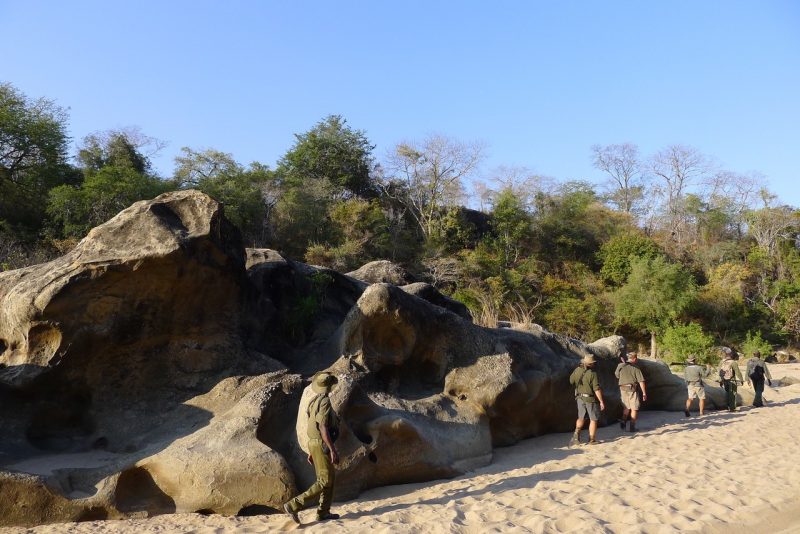
Finally, elephant hunting isn’t easy, and in my opinion is the most dangerous hunt on earth (where the animal is concerned). If done right, most elephant hunts require a hunter to walk dozens of miles tracking elephants through rough and thick terrain in search of the right animal. Then you must get in close (generally 15-30 yards) for a good shot. I don’t think there is any other animal that is more likely to charge — and kill you — when unwounded than an elephant. Every time you go in close on elephants, there is a true sense of danger, but there is also awe at being so close to such huge and majestic creatures in the wild.
The reasons I think elephant hunting is the purest of all hunts are as follows:
- It is a tracking game that requires many miles. You would think anyone can follow elephant tracks, but it is amazing how little sign these giants leave when walking through grass or over hard ground. The general consensus in Africa is that there are good trackers, and then there are guys who can really track elephants. It is an amazing part of the hunt.
- The true danger factor mentioned earlier. Often you have encounters with elephants you don’t want to shoot, and every encounter is a potential charge.
- The shot is tough. Shooting an elephant is easy, but making a brain shot is not. The brain is fairly small, and the aim point changes with every angle or movement of the head. It sits well back in the skull, so you have to be able to visualize where the brain is no matter how the elephant stands. A relaxed elephant requires a shot right between the eyes to hit the brain from the front, but if the elephant lifts its head to look at you, you might have to shoot a foot down into the trunk to properly reach the brain. All this must be done while a hunter controls his nerves being a mere 20 paces from one or more huge animals, often in thick cover. It is a tough shot.
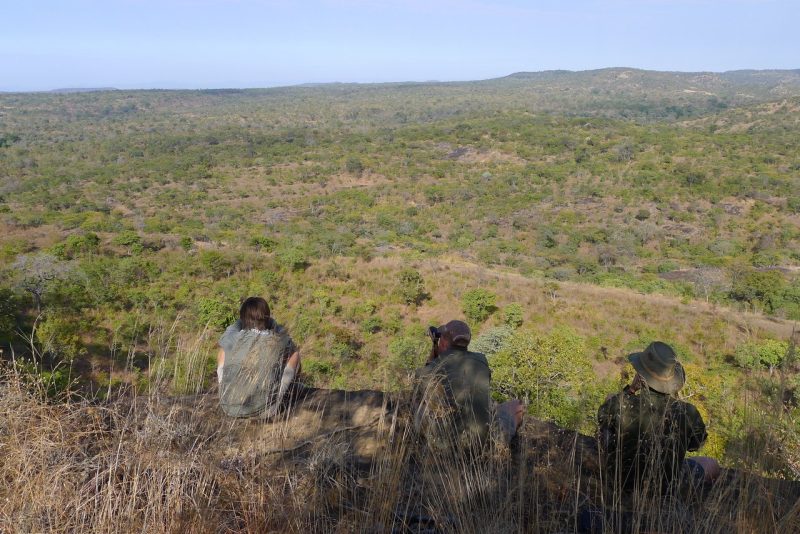
On my adventure, I was hunting with two good friends, Skip Nantz from Kentucky, and professional hunter (PH) Buzz Charlton. I have traveled to hunt with Skip for 20 years (including to Buzz’s camp), and I shot my first elephant and leopard with Buzz many years ago. So, it would be three old friends getting together for a double elephant hunt.
Skip was hunting a non-trophy bull, which means an old, mature bull, but one with inferior ivory. This gives the hunter a full elephant bull experience, still supplies the community with meat and food, but the trophy fee isn’t as high as a trophy bull. I had a cow tag, and we wanted a tuskless cow, and obviously an old, past breeding aged elephant. Again, the community and conservation benefits are there on this type of hunt.
We had 10 days in the field, and the plan was to follow big bull tracks every morning, and just try to get into elephants in general in the afternoons. We tracked and approached elephants every day. There were single bulls we walked away from, and there was a mixed group of cows and bulls that numbered nearly 50 that we just couldn’t get a shot at the big tuskless in the middle before they winded us.

One morning, we followed some bulls that eventually joined a herd, and tracking them took us over two mountains before we found them in a secluded valley in open forest. We got on a high spot in front of a small group of about 12 animals, and I will never forget seeing a line of huge foreheads emerging over a bank, headed straight at us. One big bodied bull stepped up on our level at about 17 yards, looked at us, and then we were in a stare down. Buzz whispered to me, “If he comes, shoot in self-defense”. Wow, what an adrenaline rush!
Buzz yelled loudly at the bull, and thank goodness, the animal turned and retreated, taking the others in the group with him. It was a true highlight for me.
We had another standoff with an ornery cow at about 15 yards the next day, and again Buzz gave me the green light to shoot if she came. She, too, decided to retreat into a thicket, but it was tense for a number of minutes.
On day No. 8, we were on elephants in the morning, but we didn’t get in on a suitable animal. In early afternoon, we found fresh sign leading into the hills, so off we went tracking the small herd. It was about 90 degrees, and luckily we caught up to the elephants after only about 2 miles. There was a young cow in the open to our right, and a group of eight elephants in front of us, standing under a shady tree. There was brush between us, and Buzz and I glassed the animals.
The closest elephant was a very old cow that was just what we were looking for. Buzz told me she was a perfect candidate, so we moved in. At 15 yards we stopped, and the elephant was broadside. It would have been a perfect side brain shot, and that is the easiest angle. The problem was there was another elephant directly on the far side, and when shooting a big solid bullet on a side brain shot, there is a decent chance for a pass through. We couldn’t chance hitting a second elephant.
We waited for what seemed forever, and I knew the slight breeze would shift, and the herd would blow out. The breezed did shift, but it was the young cow to the right that caught our scent and began walking away. The elephants in front saw that, and they moved a bit to see what was going on. The cow I wanted turned my way, and gave me a hard quartering-toward angle, and we knew there would be no pass through.
As you can see in the video of the hunt above, I lifted my Verney-Carron .470NE double rifle, took quick aim, and touched the front trigger. When the 500-grain Cutting Edge Bullets solid hit her just beside of the eye socket, she went straight to the ground, and the hunt was over, the right way.
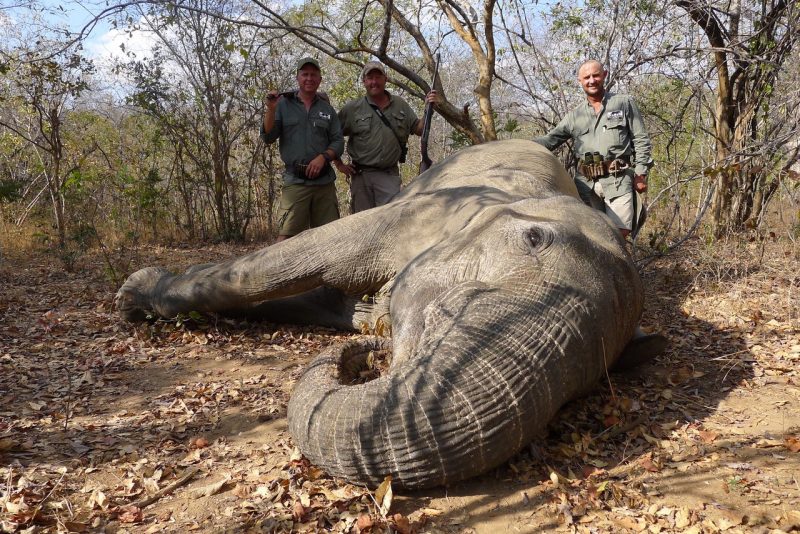
There is always sadness when an elephant is down, and it is just because we respect them so much. She was a perfect elephant to take, as her last molar was almost gone; she was on the road to literally starving to death. By tooth wear, she was estimated at 63-65 years old, and Buzz thinks she is the oldest elephant they have ever taken.
She provided tons of protein for the local villages, and people of the area were beyond thrilled to have the meat. By GPS we had walked 67 miles before we took my elephant, but we still had one to go.
The next day we tracked and were in elephants in a super thick area for about 6 hours. We put in another 7.5 miles, and just after midday, Skip was able to make a fantastic side brain shot on an old bull to finish his quest for an elephant that started back in 2012. I know he was thrilled, and it was really special for me to be shoulder to shoulder with my good friend when he finally had elephant success (photo below).
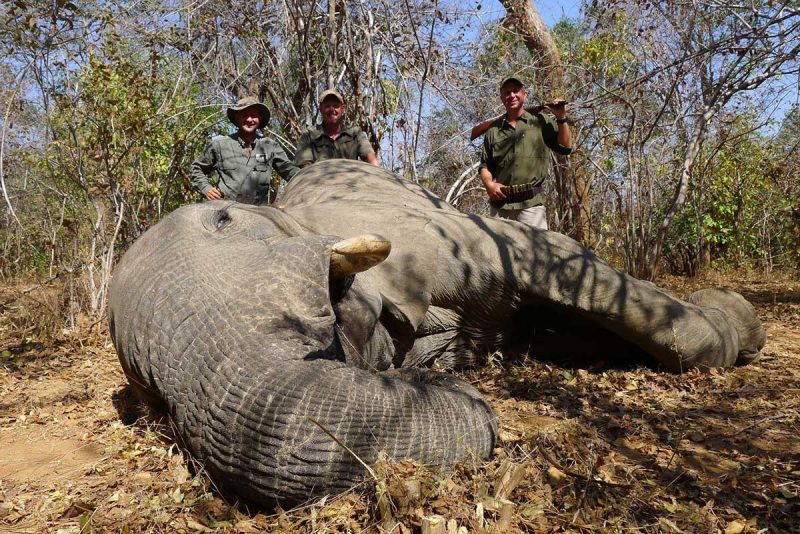
People will always argue about elephant hunting, and to each their own, but just don’t tell me and my raw, blistered feet that it is easy. After 74.5 miles on tracks, and a lot of highs and lows, no one can convince me that elephant hunting isn’t the purest of hunts.
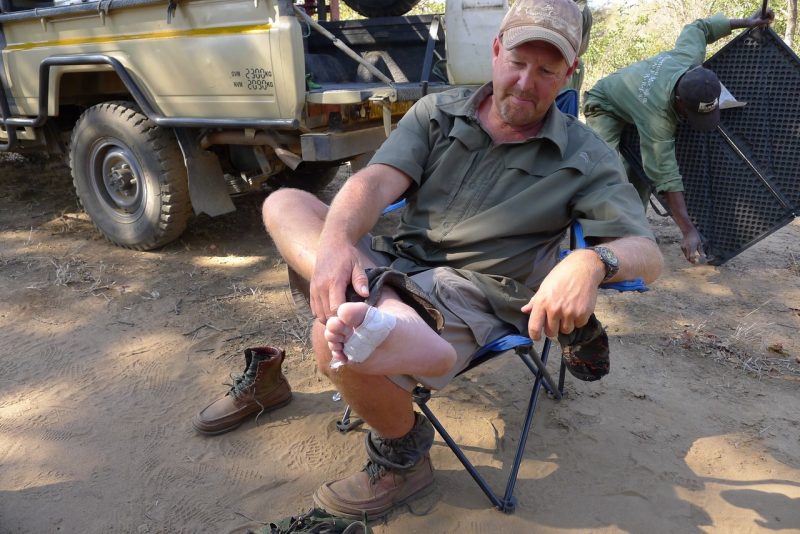
Sidebar: Big Guns and Big Bullets for the Biggest Game
On this hunt, I shot my Verney-Carron double rifle chambered in .470 NE using Cutting Edge Bullets (CEB) 500-grain solids. My VC double is my favorite rifle I have ever owned, period. It fits me like a glove, is incredibly accurate for a big bore double, and I have to admit it has classic beauty.

Though elephant shots are generally within 30 yards, and big doubles are thought of as 50-yard guns, mine is so accurate that I have cleanly taken a number of plains game species with it at distances from 110-165 yards. I even hunt antlerless whitetails with my VC, just for more practice.
The CEB 500-gr solid obviously did its job and dropped my elephant in its tracks, and the nice thing is the 500-gr solid has the same point-of-impact as the 460-gr Safari Raptor bullets that I use on buffalo and other animals. These all-brass bullets have six petals that sheer off and travel in a star shape once inside an animal, and the brass core penetrates on through like a solid. They are simply devastating, and the petals spreading out cover you on many shots if your aim isn’t pinpoint accurate. I load solids in one color of brass and Raptors in another, and that way I can tell them apart quickly — I’m always ready for any game that might present itself.
Editor’s note: Tim Herald is an owner and hunt consultant at Worldwide Trophy Adventures (WTA). To book this or any other high-quality hunt anywhere in the world, contact Tim at tim@trophyadventures.com. WTA’s services are free; WTA is paid directly by the outfitter, and your hunt cost is the same whether you book directly with an outfitter or through WTA.

